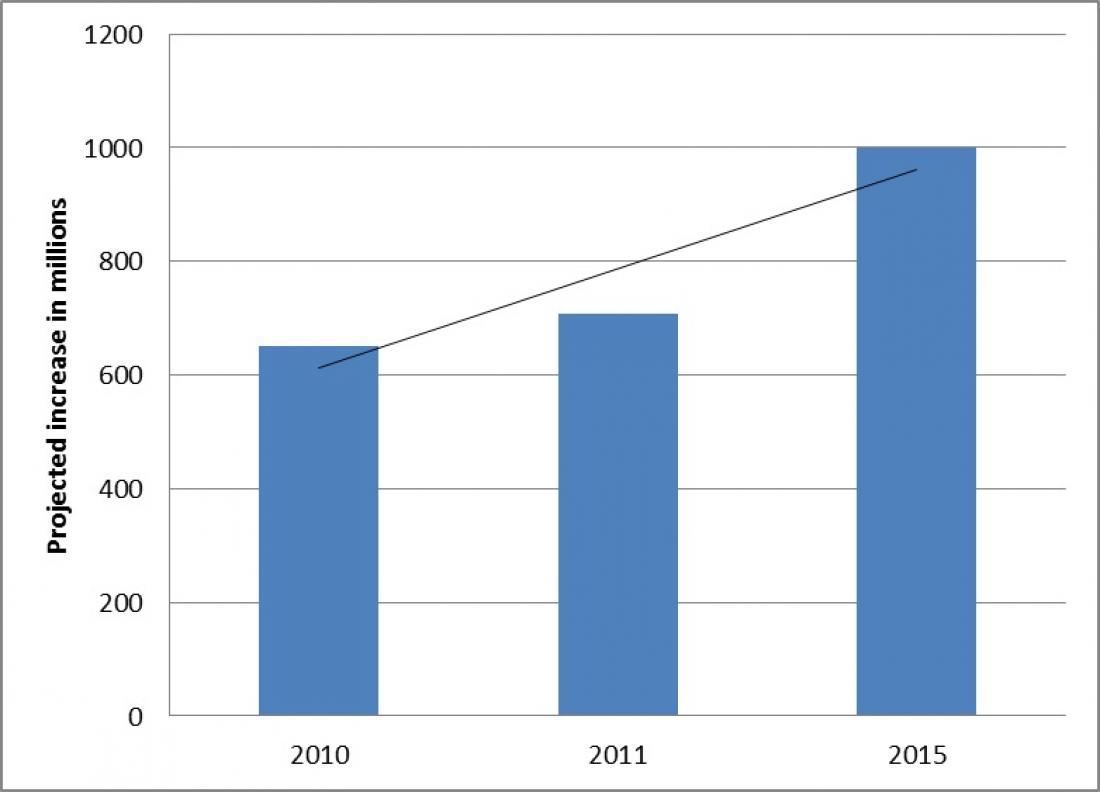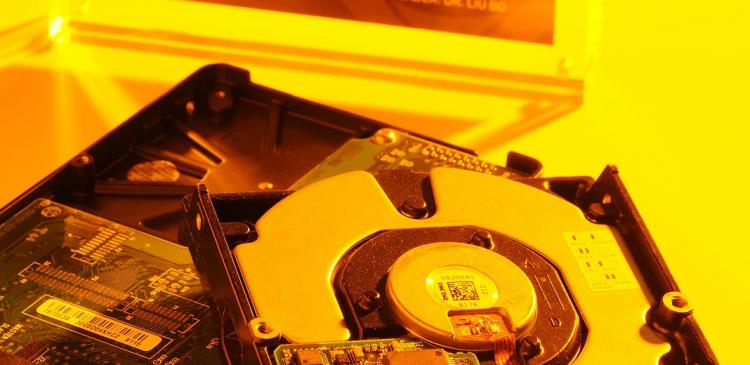Fig. 1: Based on Trendfocus, total worldwide HDD shipments increased by 16.9% over 2009, to 651.32 million units in 2010, and this is expected to rise to 708.81 million this year and go to close to 1 billion units by 2015.
The holiday pictures that you put on a CD-ROM (650 megabyte large) today would once have filled about 450 floppy discs. And even the data stored on CD-ROM is miniscule in comparison to that of a DVD (4.7 gigabyte large or 7 CD-ROMs) and that does not even begin to compare with today’s average hard-drives, which are easily 500 GB or even 1000 GB (1 terabyte or over 200 DVDs). The amount of data created by individuals, businesses and research institutes (especially institutes in the genomics sector) continues to increase exponentially due in part to the high penetration of mobile devices such as the iPhone and iPad into the general consumer market, causing the demand for data storage to become greater than ever before. As a result, hard disk drives (HDD) and solid-state storage media, such as flash memory USB devices and cards, are facing very high growth (figure 1). In fact, the demand is so high that there might be a shortage of Solid State Drives (SSD), which unlike HDD contain no moving parts and instead use flash memory and are therefore less susceptible to physical shock and vibration than HDD.
This data explosion coupled with the expansion of ‘cloud’ computing are creating an exciting and financially vibrant environment. The industry observed two multinational information technology giants, Hewlett Packard (HP) and DELL, vying for the acquisition of a small start-up (3PAR), a virtualisation and storage optimisation expert for data centers with annual revenue of less than US$100M, with HP finally paying US$2.4B for it. Oracle has also recently hired the ex-CEO of HP and declared its intention to play a major role and compete in data storage arena.
CHANGING LANDSCAPE OF HARD DISK DRIVES
While HDDs are currently the undisputed choice for mass storage devices and their future volume growth practically guaranteed by high data storage demand, there are some challenges such as improved internet bandwidth and the demands of the mobile computer user, for example. Another problem is the inability of the HDD industry to deliver the required throughput required by improved processing power of central processing units (CPUs) and the difficulty of the industry to maintain efficiency in drive recording technology, known as ‘areal density growth’. Areal density is a measure of the amount of data (calculated in bits) that could be stored within a unit surface area (one square inch) of the hard disk media. The availability of improved and low cost bandwidth is threatening the existence of HDDs in portable electronic devices such as netbooks and tablets. Faster, lower power and more robust non-volatile memory (i.e. computer memory such as flash memory that can retain stored information even when not powered) is more suitable for low capacity mobile applications.
The proposed future HDD technologies, such as Heat Assisted Magnetic Recording (HAMR) and Bit-Patterned Media (BPM), require more development to ensure high yields at low cost. Their introduction is likely to be delayed for another 3 years. In the meantime, improvements in areal density continue to be made by ‘shingle writing’ technology. Like tiles on a roof, ‘shingle writing’ technique stores overlapping data and can therefore store a greater amount, although this does have a negative impact on performance as side effect.
CHANGE DRIVERS FOR ENTERPRISE STORAGE DATA CENTERS
The future green data center and cloud computing requirements will drive change in the current enterprise data storage architecture, distributed caching, data file systems, data security, metadata, query data, etc. Take for example ‘tiered storage,’ a type of storage technology which stores data based on performance needs and frequency of access. Instead of putting all data into a single high performance storage technology which is also high in cost, storage tiering enables an organization to place data that is in high demand and accessed frequently in high performance storage media. Data that is accessed less frequently are placed into lower cost storage technology with high capacity.
Tiered storage architecture will be developed in the near future with next generation non-volatile memories either replacing or co-existing with current SSD as Tier 0, and hybrid HDDs with its high performance and lower energy consumption will replace Tier 1 high revolutions per minute (RPM) enterprise drives. Tier 2 in the future will continue to be very large, cheap but the slowest amongst the tiers. This architectural change will address the energy issue in conjunction with keeping costs and overheads manageable. In addition, very high capacity 7200 RPM or slower drives with Serial Advanced Technology Attachment (SATA) and Serial Attached Small computer system interfaces (SAS) will provide the main high capacity storage. The future of tape drives in the data storage system will also be challenged by HDDs. While NAND flash memory currently offers the right balance of cost and performance to penetrate the market, its endurance and error rates are inadequate. NAND flash memory faces competition from better forms of non-volatile solid-state memories such as Spin Torque Transfer Magnetic Random Access Memory (STT-MRAM) or Phase Change Random Access Memory (PCRAM).
OPPORTUNITIES
These changes create tremendous opportunities, especially for the Singapore based Agency for Science, Technology and Research (A*STAR) and Data Storage Institute (DSI). DSI focuses on providing solutions to the industry on next generation storage technologies. As the current Executive Director of the Institute, I combine both my industry experience with academic research to help direct into three specific areas of research: Hard Disk Drives (HDD), Non Volatile Memories (NVM) and Data Center Technologies (DCT). In HDD research, DSI is focusing efforts in extending current perpendicular magnetic recording technology, developing next generation technology such as heat assisted or energy assisted magnetic recording, shingle writing, hybrid drives and advanced integration of drives into the overall future of Data Storage Architecture. In the area of NVM, DSI is focusing its research efforts on STTMRAM and PCRAM. We are also trying to differentiate by working on scale integration issues of NVM, including controllers and signal processing. DSI also intends to work on an overall advanced Data Center technology that incorporates NVM, SSD, hybrid and high capacity drives in order to achieve better energy efficiency, cost and improved performance, further defining the data center of the future.
The research conducted by DSI using production grade equipment and state-of-the-art facilities, allow us to make a significant contribution to the world’s demands for data storage. This is very exciting indeed.
Ms Melissa Koh
Data Storage Institute
Tel: (65) 6874 6852
Email: [email protected]
ABOUT THE CONTIBUTOR
Dr Pantelis Alexopoulos, the Executive Director of Data Storage Institute, is a 29-year veteran in the data storage industry. He started his career, after graduating from Cornell University, in IBM Almaden Research Centre where he spent 14 years in various technical and managerial positions. In the late 1990s through to early 2000, he served as CTO of Maxtor.
Prior to joining DSI as Scientific Director in February 2010, Dr Pantelis was the Vice President & GM of Hitachi GST Head Business Group. He has also served as Chairman and CEO for TDK Fujitsu Philippines Corporation and as a member of DSI's Scientific Advisory Board from 2003 to January 2010.
Dr Pantelis took over as Executive Director of Data Storage Institute, a research institute of A*STAR, in June 2010.
ABOUT A*STAR
The Agency for Science, Technology and Research (A*STAR) is the lead agency for fostering world-class scientific research and talent for a vibrant knowledge-based and innovation-driven Singapore. A*STAR oversees 14 biomedical sciences and physical sciences and engineering research institutes, and six consortia & centres, located in Biopolis and Fusionopolis as well as their immediate vicinity.
A*STAR supports Singapore's key economic clusters by providing intellectual, human and industrial capital to its partners in industry. It also supports extramural research in the universities, hospitals, research centres, and with other local and international partners.
About the Data Storage Institute (DSI)
The Data Storage Institute (DSI) is a member of the Agency for Science, Technology and Research (A*STAR). Established in 1992 as the Magnetics Technology Centre (MTC), it was renamed Data Storage Institute in 1996. The research institute's vision is to be a vital node in a global community of knowledge generation and innovation, nurturing research talents and capabilities for world-class R&D in next generation storage technologies.




